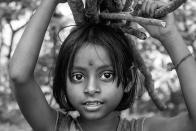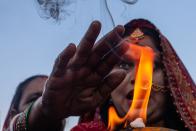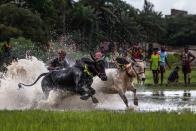Guru Jwala Tiwari: An Era of Indian Kushti
Guru Jwala Tiwari: An Era of Indian Kushti
Jwala Tiwari, a former state-level wrestler and the head of one of the city's final remaining akharas on the banks of the Hooghly, passed away on Sunday. He was 65 years old.Up until the middle of the 1990s, this wrestler, who specialized in clay pit wrestling, had represented Bengal in a number of competitions. He won silver and bronze in a number of competitions held by various state wrestling authorities. Many pehlwans who later competed for the state in wrestling were also trained by him in his akhara.
Malla-yuddha refers to the traditional Indian style of grappling. It was the forerunner to modern Kushti, having been practiced at least since the fifth millennium BC, as noted in the 13th-century treatise Malla Purana.While wrestling on the Indian subcontinent underwent changes during the Mughal and colonial eras, training regimen has remained the same for more than 150 years. Although young wrestlers can start as early as age 6, most wrestlers start formal training in their teens.
When akharas were the only locations for bodybuilding forty years ago, the situation was not as it is today. The akharas have lost their former prominence and glory with the introduction of high-tech gyms and various steroid-filled capsules. In these modern times most teenagers in the city, who are conscious of their physique, prefer a modern gymnasium to an akhara, and those who come to learn are constrained by their economic conditions to learn it properly. Any physical activity requires a healthy diet, and most of these students cannot afford quantity of milk considered necessary to improve their health and physique.
Guru Jwala Tiwari, a former national wrestler and founder of Siyaram Akhara Bayam Samity, has worked as a security guard in his locality to ensure he is able to offer proper nutrition to those training in his akhara.
He moved to Kolkata 35 years ago from Gorakhpur in Uttar Pradesh and comes from a pehelwan family. There was too much rivalry, too many wrestlers competing in small-scale local tournaments for meagre prizes. A wrestler with aspirations of founding his school and producing champions was drawn to Kolkata by its allure of the unknown and uncharted.
The sport of wrestling is now performed on mats according to Olympic standards. Traditional wrestling, or kushti, is still played in India in akharas on freshly dug ground that has been blended with ghee, turmeric, neem, and water.
This ancient tradition is fading in contemporary India due to pressure to meet international wrestling standards and win Olympic medals. It is a tradition that dates back to the Mughal era, but it is still alive and well in some remote areas. The Siyaram Akhara still practices this custom today on the banks of the Ganga in Kolkata, in front of the Howrah bridge. Practitioners of all ages, from young boys to teenagers, go through a strenuous training schedule that starts hours before sunrise under the watchful eye of guru Jwala Tiwari.
Many students of this prestigious establishment in Kolkata work at the many cottage factories that are scattered throughout the city. Since, they are from rural families and require this extra income to make ends meet while nurturing their bodies to continue on their chosen path. Their attention is sharpened by leading a pure life, gaining strength, and imitating a champion pehlwan as a result of the daily training at the akhara, the strict diet, and the requirements of celibacy.
Even though wrestling is an international sport and these akharas are unable to afford expensive equipment like wrestling mats these individuals still command respect, power, and honour in these regions of India.
This school is situated close to the flower market and the Mallik Ghats on the Hooghly. Under the direction of national wrestler Guru Jwala Tiwari, a yellow sign identifies it as the Siyaram Akhara Bayam Samity. An old building with peeling paint and stained windows is located behind the akhara.
Steps outside the akhara lead to the ghats, a small improvised temple with a number of idols where worshippers leave milk, oil, and flowers as sacrifices. The wrestling arena is an open pit enclosed by white-washed pillars and decorated with vibrant bunting. This area is holy to these pehelwans and even visitors are asked to remove their footwear. The mud in the pit is unique and made with herbs, turmeric powder, ghee, and mustard oil rather than being common or from the streets.
Jwala Tiwari was a muscular middle-aged man who enjoyed discussing his hobby with complete strangers. His strength and grit were concealed by a thinning hairline and a large stomach. While it will always be common to see young men training in akharas, more women are also joining the akharas today.
Most individuals do not lose or gain much weight even after giving up practicing khusti daily. With the aid of various exercises, anyone who visits this akhara to learn kushti is toughness-trained.
Senior members of the akhara teach the youngsters different Pahalwani techniques once they are satisfied with their physical prowess. For every student, developing physical strength is the biggest challenge. Engaging in daily physical activity, such as weightlifting and free-hand exercises, increases flexibility and fitness that one gains from a session at the akhara.
Guru Jwala Tiwari, who expired on 1st January 2023, has personally educated and trained his son to walk in his footsteps and compete in wrestling competitions so that he not only brings glory to his father’s name and family but also inspires youngsters to join akharas and continue this cultural heritage that has been passed down through numerous generations.
He had experienced several heart-related illnesses over the previous two years. The final rites were performed on his mortal remains in Banaras. He was among the last leaders to teach wrestling in clay pits, as most kids today prefer to practice on wrestling mats.




